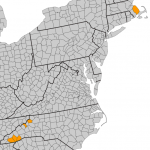The “Pink Group” all bloom in early spring, usually before the leaves have fully expanded. Flowers range from pale pink, to deep rose, to almost cherry red. There are five species in this group: R. canadense, R. canescens, R. periclymenoides, R. prinophyllum, and R. vaseyi.


Rhododendron canadense is a very unusual native azalea species and was originally considered an entirely separate genus, Rhodora. The top three petals of the flower are fused together almost to the end to form a single lobe, whereas the bottom two are completely separate lips. The purplish pink blossoms are approximately 1.5 inches across and have 10 stamens, twice the number of most east coast natives. There are white forms of this species.
First described by Linnaeus in 1762, R. canadenseis a low stoloniferous shrub that grows along stream banks and in swamps in eastern North America from Pennsylvania into Labrador. The most northern of the east coast native azaleas, the species is very cold hardy but a difficult plant where summers are hot and dry.

Rhododendron canescens, the piedmont or Florida Pinxter Azalea, is a striking native species. The fragrant flowers are 1 to 1.5 inches across, and come in shades of pink to white with usually no blotch. The stamens are quite long , usually twice as long as the tube.
Discovered by Mark Catesby about 1730, R. canescens is often confused with R. periclymenoides (R. nudiflorum ) but can be distinguished by the sticky glandular hairs on the tubes of the flowers and some other morphological characteristics.
Although typically considered a southern species, R. canescens is a hardy shrub that deserves wider landscape use. The 4 to 5 foot plant makes a spectacular spring show since the flowers open before the leaves have expanded.


R. periclymenoides (synonymous with R. nudiflorum is the common Pinxterbloom Azalea found in the lower Appalachian Mountains, Piedmont and Coastal Plains from Massachusetts to north Georgia and Alabama. The white to pink flowers open in mid spring as the foliage is expanding, are they slightly fragrant. The blossoms measure approximately 1 to 1.5 inches across and the stamens are more than twice the length of the corolla tube.
Discovered by the Rev. John Banister and introduced to England in 1734, this species is often confused with R. canescens. In addition to differences in the natural range of the two species, R. periclymenoides can be distinguished by its flower tubes which are typically fuzzy or pubescent but do not have sticky glandular hairs on the back.


Rhododendron prinophyllum (synonymous with R.roseum can be found from southwestern Quebec, through New England and northern Ohio, to the Appalachian Mountains at the higher elevations. The flowers are typically rose pink measuring 1.2 to 1.8 inches across and are very fragrant.
Assumed to be a form of R. periclymenoides (R. nudiflorum) since its first mention in 1787, it was first described as a distinct species in 1914 by Small but had been under cultivation as A. rosea in Europe before 1812. R. prinophyllum can be distinguished from periclymenoides by a number of characteristics including the fact that it is usually deeper pink in color and with a strong cinnamon to clove fragrance. Also, the blossom it is more funnel shaped with comparatively short flower tube, and the pedicels (flower stalks) are longer than the other species.
R. prinophyllum is a wonderful landscape plant for north eastern gardens, but may be more difficult in the south because of summer heat.

Rhododendron vaseyi, the rare Pinkshell Azalea, is one of the first species to bloom in the spring. Its delicate pink to white flowers are typically flat-faced, about 1.5 to 2.25 inches across, and have some prominent spotting in the throat.

Discovered by George Vasey in 1878, this native azalea has a relatively restricted natural habitat in four mountainous counties of North Carolina. Growing at elevations of 3000 to 5500 feet, plants can be seen in bloom along the Blue Ridge Parkway in early spring.
R. vaseyi makes an excellent garden plant, and can be purchased plants from number of commercial sources. Please, never take plants from the wild.




















